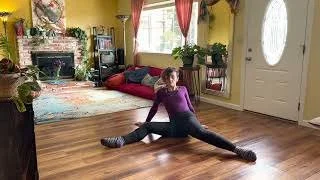Jill Hardy - Loop Written Overview (1B)
1. Ingredients:
a. Straddle sit
b. Lie on stomach
c. Sit up
2. Description:
a. I chose these ingredients because they are simple positions that are accessible to anyone, but there is also a lot of potential to add in different skills and variations within them.
b. Leading up to filming this… I’m sick and working with an energy deficit, so I knew I wanted something gentle and easy.
i. I taught a version of this loop in a class recently to help students integrate some leg swing variations we worked on, including the one that appears at the end of the loop. In my class I went right to the final version of the loop (the students were more advanced and could definitely handle it). To come up with this progression, I teased out the most basic ingredients of that loop – straddle sit, lying on the stomach, then sitting up – and started with those, letting the transitions be whatever came naturally.
ii. To get into the right state to flow, I took some breaths at the beginning, stretched a bit to activate my proprioception, and grounded down into my contact with the floor. That dropped me right in.
3. What felt good: moving like molasses felt SO good. Like I mentioned, I was pretty exhausted filming this and I loved being able to meet myself in that tired place and roll with it. After doing that, I naturally wanted to start moving a bit faster, so it felt good to pick up the pace, then add in the challenge of incorporating specific skills (like the seated leg swing transition to lying on the floor and the cat pounce to sitting).
4. One thing I’d do differently: think in more detail about the directionality of this loop. The seated V is a symmetrical position, as is the seated position I end up in after the cat pounce, which leaves room for confusion about which way to go next. It’s easy for me to know which way feels good to go, but as a teacher I would like to provide more clarity about that.
5. What I learned:
a. See above!
b. When I design loops for my class, they tend to incorporate whatever skill we have been working on straight away. Doing this exercise reminded me that I can get even simpler and more accessible by starting out with the most basic elements and then layering in skills over that. This will be especially useful for classes when I have beginner students so everyone has an option to loop at a level that feels awesome to them.

